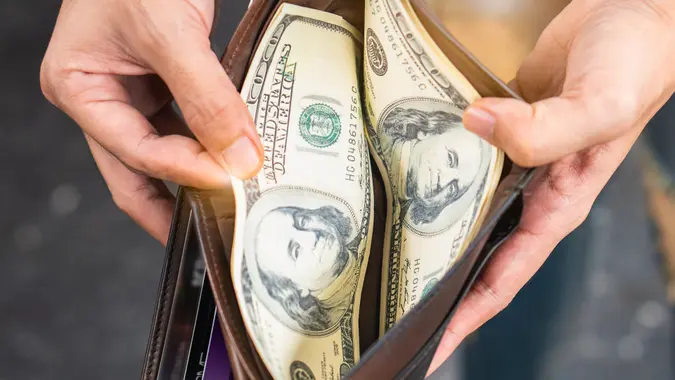Advertiser Disclosure
GOBankingRates works with many financial advertisers to showcase their products and services to our audiences. These brands compensate us to advertise their products in ads across our site. This compensation may impact how and where products appear on this site. We are not a comparison-tool and these offers do not represent all available deposit, investment, loan or credit products.
12 Simple Ways People Can Go From Spenders to Savers in 2024
 Written by
Angela Mae Watson
Written by
Angela Mae Watson
 Edited by
Susan Kim
Edited by
Susan Kim

Commitment to Our Readers
GOBankingRates' editorial team is committed to bringing you unbiased reviews and information. We use data-driven methodologies to evaluate financial products and services - our reviews and ratings are not influenced by advertisers. You can read more about our editorial guidelines and our products and services review methodology.

20 YearsHelping You Live Richer

Reviewed by Experts

Trusted by Millions of Readers
People talk about how important it is to save money, but if you tend to spend more than you save, switching to a saving mentality can be tough. Even if you want to save more money, you might not know how to do it. Or you might think you need to start living extremely frugally and budgeting every penny you earn to make sure you’re saving enough — whatever that might look like for you.
The good news is that there are ways to go from a spender to a saver. From quick, easy methods to strategies that require a bit more planning, here are some ways to do just that in 2024.
Save a Portion of Your Paycheck
A simple way to save more is to allocate a portion of your monthly paycheck to savings every month without fail.
“It can be difficult to know exactly how much you should spend each month if you don’t have a plan created — some people call it a budget, but that term can feel daunting. I call it an intentional spending plan,” said Julie Beckham, financial education officer at Rockland Trust.
“Everyone’s exact spending plan will look different depending on your goals or priorities,” she said. “An example of what a monthly paycheck allocation could look like [is] rent (25%), household bills (25%), spending money (15%), savings (20%) and paying down any outstanding debts (15%).”
Automate Your Savings
“Automating saving can make it easier and take one thing off your to-do list,” Beckham said. “Consider having a portion of your check directly deposited into an existing or new savings account. You’ll be surprised how quickly those savings grow!”
Start Saying No
If you’re trying to save more and spend less but social pressure is getting to you, remind yourself that it’s okay to say no to certain things. You don’t have to decline every invitation to go out, but cutting back every now and then can help. The same goes for those little things you buy just because you feel like you should.
“When you are spending on items or experiences (coffee, concerts, clothes, travel) on things that don’t really light you up, you should think twice about saying yes and swiping your card,” said Gloria Garcia Cisneros, CFP, a wealth manager at LourdMurray. “We feed into the FOMO, but this causes unnecessary spending.”
Save Up the Change
If you still use cash to pay for things, save your spare change.
“Grab those coins from under the couch cushions and put them to work for you!” Beckham said. “Consider putting loose change into a jar or other container and then depositing it every month at your bank.”
And if you don’t use cash, you can always get a free app that lets you round up your digital transactions. Every amount you round up can then go directly into your savings account.
Differentiate Between “Needs” and “Wants”
“The best practice when it comes to saving money is to live within your means,” said Brandon Stout, a relationship advisor at Addition Financial Credit Union. “Practice the ‘needs’ vs. ‘wants’ discipline and only prioritize your essential needs.”
“It’s important to understand that social expenses can add up, so creating a spending plan that distinguishes ‘wants’ and ‘needs’ can be beneficial,” Beckham said. “Responsibly saving doesn’t have to feel so restrictive if you can focus spending on items that are the most important to you.”
Cancel Unnecessary Subscriptions
All those monthly subscriptions add up — sometimes to hundreds of dollars a month. Going through yours and canceling the ones you don’t really need or use can be an easy way to spend less and save more.
“I would recommend for individuals to check their account history for subscription services that they forgot about or no longer use,” Stout said. “Canceling these services will add up over time and is a vital part of switching into a ‘savings mindset.'”
Switch to Cost-Friendly Alternatives
At the store, you can buy generic, buy in bulk, use coupons or loyalty programs, and shop the deals — but only for things you actually need. When hanging out with friends, you can also cut down on spending by switching to cost-friendly alternatives.
“If spending money on an extravagant night out or dream vacation isn’t in the cards right now, suggest a cost-friendly alternative,” Beckham said. “Hosting a movie night at home or exploring local hiking trails with friends can be just as fun, and the chances are, your friends might be looking to save a bit of cash as well”
Shop Around
“If you’re paying too much for car insurance or your cellphone, see what you can save,” said Scott Lieberman, founder of Touchdown Money. “You can move around just like they can, and that means more money in your pocket.”
The same goes for other services. Contact your utility companies, internet service provider and so on to see if you can get lower rates. Save the difference.
Set Financial Goals
Setting financial goals might feel daunting, but sometimes having a goal really is the easiest way to start saving more.
“It is much easier to save money when you have a goal in mind than to save for savings’ sake. Goals provide motivation to save,” said Barbara O’Neill, CFP at Annuity.org. “Determine the amount that you need to save to buy something (e.g., car down payment) or do something (e.g., travel) and how much time you have to complete the goal. Then, ‘do the math’ to see how much savings is needed per week or month to reach the target amount.”
For long-term goals, reward yourself in small ways as you go. This could be something as simple as going to a cafe once a week. Or it could be getting that ticket to your favorite performer in concert. Whatever it is, these small rewards can really help you stay motivated.
Go DIY
If you’re handy, see if you can do more things yourself rather than paying someone.
“For example, you can try getting DIY furniture instead of paying someone to put it together,” Lieberman said. “For things like plumbing or car repairs, don’t try this.”
Switch to a Higher-Yield Account
Another simple way to save in 2024 is to simply use a different type of savings account, one with a higher yield.
“Contact your financial institution and see how you can make your funds work for you,” Stout said. “Higher-yield savings accounts and money market accounts are a great tool to help grow your assets while keeping them liquid!”
Practice Mindful Money Habits
“The initial step in changing from a spending mindset to a saving mindset is one word: awareness,” said David Roach, MBA, an instructor for Texas A&M Financial Planning Program at Texas A&M AgriLife. “The best way to do this is by creating a budget or a life spending plan.”
Don’t be afraid to make changes as you go. Life happens, and you can adjust your spending and saving habits accordingly.
“Thankfully, creating a life spending plan does not have to take a lot of time,” Roach said. “Gone are the days of spending your entire weekend finding receipts and waiting for your paper bank statements in the mail … There is so much technology, like budgeting apps, at our fingertips that makes things easy. Most banks will even categorize your expenses for you.”
You don’t need to rush to change your habits. Knowing where your money goes every month is half the battle.
“With this newfound financial awareness, you can start to gradually impact your financial behaviors,” Roach said. “This is how you switch to a savings mindset. Learn about yourself: your money habits, your emotions and where you spend your money.”
More From GOBankingRates
- Nearly 1 in 3 Americans Hit by a Costly Holiday Scam, Norton Survey Shows -- How To Avoid This
- Here's What Retirees Wasted the Most Money On in 2025 -- and How To Avoid It in 2026
- How Middle-Class Earners Are Quietly Becoming Millionaires -- and How You Can, Too
- 6 Safe Accounts Proven to Grow Your Money Up to 13x Faster
Share This Article:




You May Also Like




Warren Buffett's 7 Rules for Saving Money on Everyday Expenses Without Sacrificing Comfort
December 26, 2025
8 min Read


Cut These 5 Things So Your First 20 Days of Work Each Month (More Than) Covers Your Bills
December 26, 2025
8 min Read









Make your money work for you
Get the latest news on investing, money, and more with our free newsletter.
By subscribing, you agree to our Terms of Use and Privacy Policy. Unsubscribe at any time.


Thanks!
You're now subscribed to our newsletter.
Check your inbox for more details.



Sending you timely financial stories that you can bank on.
Sign up for our daily newsletter for the latest financial news and trending topics.
For our full Privacy Policy, click here.
Looks like you're using an adblocker
Please disable your adblocker to enjoy the optimal web experience and access the quality content you appreciate from GOBankingRates.
- AdBlock / uBlock / Brave
- Click the ad blocker extension icon to the right of the address bar
- Disable on this site
- Refresh the page
- Firefox / Edge / DuckDuckGo
- Click on the icon to the left of the address bar
- Disable Tracking Protection
- Refresh the page
- Ghostery
- Click the blue ghost icon to the right of the address bar
- Disable Ad-Blocking, Anti-Tracking, and Never-Consent
- Refresh the page


